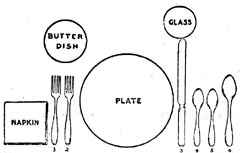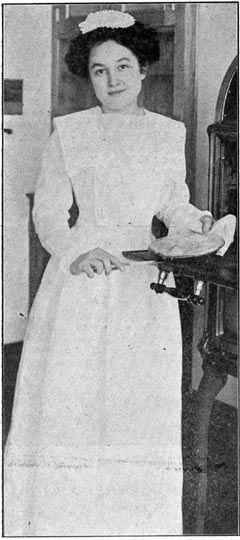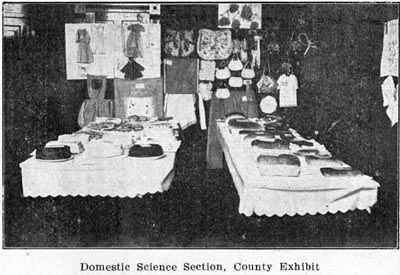Silver:
1. Salad fork
2. Dinner fork
3. Dinner knife
4. Dessert spoon
5. Coffee spoon
6. Soup spoon

NEGenWeb
Project
Resource Center
Schools
|
|
135 |
41. Baked Corn Bread, or Golden Corn Cake
3/4 c cornmeal
1/2 tsp salt
1 1/4 c flour
1 c milk
1/4 c sugar
l egg
4 tsp baking powder
1 tbsp melted butter
Mix and sift dry ingredients; add milk, egg well beaten, and butter; bake in shallow buttered pan in hot oven 20 minutes. The above amount will make a cake about two inches thick, if baked in pan 6x8 inches.
1 c rye-meal
2 c sour milk
1 c granulated corn-meal
3/4 tsp soda
I c graham flour
1 tsp salt
3/4 c molasses
"Mix and sift dry ingredients; add molasses and milk, stir until well mixed; turn into a well-buttered mould, and steam three and one-half hours. The cover should be buttered before placing on mould, and then tied down with string; otherwise bread in rising might force cover. Mould should never be filled more than two-thirds full,"
1/4 c butter
1/2 tsp soda
1/2 c molasses
1 1/2 c graham flour
1/2 c milk
1 tsp salt
1 c raisins, seeded and cut up
"Melt butter, add molasses, milk, egg well beaten, dry ingredients mixed and sifted, and raisins; turn into buttered mould, cover, and steam two and one-half hours."
To one-half cup sugar and three tablespoons corn starch add gradually, stirring constantly, one cup boiling water. Boil two minutes. Flavor with salt and vanilla extract.
45. Boiled Custard
2 c scalded milk
1/4 c sugar
Yolks 3 eggs
1/8 tsp salt
1/2 tsp vanilla
Beat eggs slightly; add sugar and salt; stir constantly while gradually adding hot milk. Cook in double boiler; continue stirring until mixture thickens and a coating is formed on the spoon; strain Immediately; chill and flavor
|
136 |
|
2 c scalded milk
1-3 c cold milk
5 tbsp corn starch
1 1/2 squares Baker's chocolate
1/2 c sugar
3 tbsp hot water
1/4 tsp salt
Whites of 3 eggs
1 tsp vanilla
Mix corn-starch, sugar, and salt; dilute with cold milk; add to scalded milk, and cook over hot water ten minutes, stirring constantly until thickened; melt chocolate, add hot water, stir until smooth, and add to cooked mixture; add whites of eggs beaten stiff, and vanilla. Mould, chill, and serve with cream.
Silver: |
|
Illustration showing placing of china and silver in setting the table. In using silver, use from the outside.
47. White Cake
1 c butter
2 tsp baking powder
2 c sugar
3 c flour
1 c water
Whites of 4 eggs
Cream butter and sugar. Add water and sifted dry ingredients alternately, stirring well. Fold in stiffly-beaten whites. Spread batter evenly in well greased cake tins. Bake in moderate oven fifteen to twenty minutes.
Stiffly beaten whites of 2 eggs
1/2 c boiling water
1 c sugar
5 marshmallows
1/2 tsp vanilla
Boil sugar and water until it spins a fine thread when dropped from spoon (about three minutes). Pour slowly over beaten whites, beating constantly with fork; add the marshmallows cut in small pieces. Beat until cold. Add flavoring. Spread on cake.
To boiled icing add 1/2 c cocoanut, 1/2 c chopped nut meats. Spread on crackers, bake in very slow oven until delicately browned.
|
|
137 |

|
138 |
|
1 1/2 c flour
1-3 c lard
1/2 tsp salt
Cold water
1/2 tsp baking powder
Mix flour, salt and baking powder thoroughly. Rub lard in with tips of fingers. Moisten sufficiently to roll out. Leave crust a little larger than pie tin to allow for shrinkage. Perforate top crust to allow escape of steam. Bake in quick oven, unless filling demands slow cooking.
These recipes may be furnished by the girls, each one who has a good recipe bringing it for the others to try. It may be desirable to have the candy lessons before the holidays, so that the girls may make their own Christmas candy.
The teacher should be careful to give seasonable recipes at all times. It is easier to keep up interest In this way. It is also more economical to buy supplies in season.

BACTERIA, YEASTS, AND MOULDS
Experiment 13. Partly fill a sauce dish with jelly, carefully smoothing the top. Expose the jelly to the air of the schoolroom or living room. In about twenty-four hours various colored specks and spots appear. Note the delicate yellows, greens, and blues.
|
|
139 |
Watch the growth of these for several days, noting those which grow tall and feathery, and the others which are shiny, waxy, and low. Note also the dust-like material flying from the tall, feathery plants. We call them plants for they grow like plants. Like plants they require warmth and moisture, and the dust-like material observed flying from the plants are their seeds. The seeds of these plants are called spores.
The plants with which we are familiar all have names, and belong to different classes depending upon their different characteristics. These very small plants in the jelly are also divided into classes and have names. All of the smallest and simplest plants are In the first class and are named Bacteria.
Bacteria are so small that a single plant can he seen only by the use of a microscope to magnify it many times. They take their food from the air or surrounding material, then give off as waste products gases or liquids. These waste products may do harm or good. In the case of ptomaine poisoning we see the harm they do. Another common example of the work of bacteria is the souring of the milk.
In the second class are found the yeast plants with which we are all familiar. We put the yeast in the bread. It grows, and while growing throws off alcohol and a gas which is called carbon dioxide. The bubbles of gas cannot break through, so they raise the whole mass of dough.
The third class are the moulds which form a velvet-like substance in bread, on meat, leather and canned goods. Other forms of mould are mildew, ringworm and moulds on the skin.
We performed some experiments which show favorable and unfavorable temperatures for the growth of these plants. Sunlight and draughts of air retard or destroy germ life. We conclude then that the best way to avoid germ life in food is either to keep the food la a refrigerator or very cold place, or else to boil or bake it before using. The best way to avoid the germ life in the various rooms of the house is to air thoroughly the rooms, admit all the sunlight possible, and keep as free from dust as possible.
All that has been said of the house applies to the barns and milk rooms as well. Attention will be called later to the pure food laws which are requiring cleanliness in the handling of milk, butter, meat and all foods.
Successful canning and preserving depends first upon the destruction of all bacteria, yeasts, and moulds present in the vegetable or fruit; and secondly upon perfect sealing so that no new germ is admitted. Great care must be taken in order to prevent the spoiling of any foods kept for winter use. The first precaution Is to use earthen or granite ware utensils, and to use sliver or wooden spoons only, for stirring.
|
140 |
|
The second precaution is to cook thoroughly the material so that all germ life is thoroughly destroyed.
The third precaution is to cleanse thoroughly with boiling water the glass or can In which the material is to be kept, to fill the hot receptacle over full while the material is at boiling temperature, and to seal the receptacle at once.
Vegetables are prepared as for sauce, observing all the precautions noted above.
There are many ways of keeping fruits for winter use.
"12 quarts raspberries
2 quarts sugar
"Put 2 quarts of the fruit in the preserving kettle, heat slowly on the stove; crush with a vegetable masher; spread a square of cheese cloth over a bowl, and turn the crushed berries and juice into it. Press out the juice, then turn juice into the preserving kettle. Add the sugar and put on the stove; stir until the sugar is dissolved. When the sirup begins to boil, add the remaining 10 quarts of berries. Let them heat slowly. Boil ten minutes, counting from the time they begin to bubble. Skim well while boiling. Put in cans and seal as directed."
Farmers' Bulletin No. 203. This bulletin may be obtained by request from the U. S. Department of Agriculture.
"Treat the same as raspberries."
"12 quarts currants
4 quarts sugar
"6 quarts cherries
1 1/2 quarts sugar
1/2 pint water
"Measure the cherries after the stems have been removed. Stone them or not as you please. If you stone them be careful to save all the juice. Put the sugar and water in the preserving kettle and stir over the fire until the sugar is dissolved. Put in the cherries and heat slowly to the boiling point. Boil ten minutes, skimming carefully."
Dip sweet, ripe cherries which have not been stemmed into stiffly-beaten egg white. Immediately dip into granulated sugar. Let dry about twenty minutes. Serve as dessert.
|
|
141 |
"6 quarts grapes (stemmed)
1 quart sugar
1/4 c water
"Squeeze the pulp of the grapes out of the skins. Cook the pulp five minutes and then rub through a sieve that is fine enough to hold back the seeds. Put water, skins, and pulp into the preserving kettle and heat slowly to the boiling point. Skim the fruit and then add the sugar. Boil fifteen minutes."
"8 quarts peaches (pared and halved)
1 quart sugar
3 quarts water
"Pare the peaches, cut in halves, and remove the stones, unless you prefer to can the fruit whole.
"Put the sugar and water together and stir over the fire until the sugar Is dissolved. When the sirup boils, skim it. Draw the kettle back where the sirup will keep hot but not boil.
"Put a layer of the prepared fruit into the preserving kettle and cover with some of the hot sirup. When the fruit begins to boil, skim carefully. Boil gently for ten minutes, then put in the jars, and seal. If the fruit is not thoroughly ripe it may require a little longer time' to cook. It should be so tender that it may be pierced easily with a silver fork. It is best to put only one layer of fruit in the preserving kettle. While this is cooking the fruit for the next batch may be prepared."
Two-thirds of all disease is caused from eating the wrong kind of food or food improperly cooked. To cure such disease a corrected diet is of as great importance as medicine.
It is of great importance in caring for the sick or convalescent to select the cleanest and daintiest of glass, china, silver, and linen when arranging the tray.
It is important also to serve easily digested foods. Liquid foods, milk, lemonade, fruit juices, oatmeal water, beef tea and egg-nogs are among the best.
The semi-solid foods are the gruels made from corn-meal, oatmeal, Imperial Granum, flour, starch, crackers, or arrow-root. They are heat producing. Care should be taken not to serve them when there is inflammation of the stomach or Intestines.
Greatest care must be exercised in the giving of solid foods, especially during convalescence. The danger is that too much will be given. Among the best foods are fresh eggs cooked soft, dry and milk toast, chicken cooked until the flesh falls from the bone, custards, ices, and ice creams. High seasonings should be avoided.
To the subject of lunches a great deal of attention should be
 |
 |
 |
 |
|
© 2003 for the NEGenWeb Project by Ted & Carole Miller |
|||